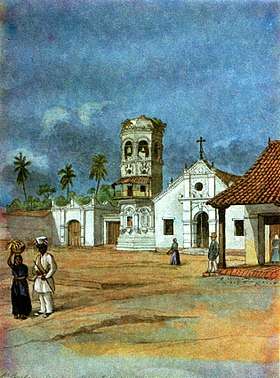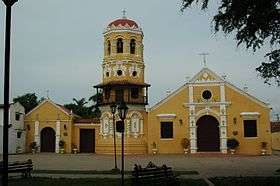Santa Cruz de Mompox
Mompox or Mompós, officially Santa Cruz de Mompox, is a town and municipality in northern Colombia, in the Bolívar Department, which has preserved its colonial character. Mompox depends upon tourism, fishing and some commerce generated by the local cattle raising. It has about 30,000 inhabitants, and is adjacent to the municipalities of Pinillos and San Fernando.
Santa Cruz de Mompox | |
|---|---|
Municipality | |
 View of Mompox from the Magdalena River | |
 Flag  Seal | |
 Municipality and town of Mompox in the Bolivar Department. | |
| Country | |
| Region | Caribbean Region |
| Department | Bolivar Department |
| Foundation | 3 May 1537 |
| Founded by | Alonso de Heredia |
| Government | |
| • Mayor | Nubia Isabel Quevedo Ángel (2016-2019) |
| Area | |
| • Municipality | 645.37 km2 (249.18 sq mi) |
| Elevation | 33 m (108 ft) |
| Population (2015) | |
| • Municipality | 44,124 |
| • Density | 68/km2 (180/sq mi) |
| • Urban | 25,785 |
| Time zone | UTC-5 (Colombia Standard Time) |
| Website | Official website |
| Official name | Historic Centre of Santa Cruz de Mompox |
| Criteria | Cultural: (iv)(v) |
| Reference | 742 |
| Inscription | 1995 (19th session) |
Simón Bolívar, liberator of much of Spanish South America, said "If to Caracas I owe my life, then to Mompox I owe my glory." Simón Bolívar arrived in Mompox in 1812 and recruited nearly all of the able bodied men, some four hundred, who formed the basis of the army for his victory in Caracas.
History
Mampo (or Mompoj) was the local indigenous chieftain of the Malibu culture, when the Spanish conquistadors arrived, and Mompox means "land of the ruler Mampo". The city was founded on May 3, 1537 by Alonso de Heredia, brother of Pedro de Heredia, as a safe port on the Magdalena.[1] Santa Cruz de Mompox became quite prosperous as a port for the transportation of goods upriver into the interior. A royal mint was established here and the town was famous for its goldsmiths. This prosperity had begun to wane in the nineteenth century, but continued until early in the twentieth century when the river shifted and sediment accumulated on this arm of the river, at which point Magangué became the favored port.
Buildings and architecture

Santa Cruz de Mompox is known for the preservation of its colonial architectural features, as expressed by the mixture of its Spanish and Indian styles. UNESCO named the historic center of Mompox as a World Heritage Site in 1995. Today, most of the colonial buildings are still used for their original purposes, which provides an excellent example of a Spanish colonial city. Of particular note is the wrought iron work decorating doors, railings and window grills along the streets, notably on Calle de la Albarrada, Calle Real del Medio and Calle de Atrás. Notable churches include Santa Bárbara (built 1613), San Agustín (built 1606), San Juan de Dios and Immaculate Conception. There is also a museum of colonial art which houses religious gold colonial masterpieces.
- The San Francisco Church was originally built in 1564 and the convent was founded in 1580 by Fray Francisco Gonzaga. The church is known for its handsome mural which was unfortunately damaged during reconstruction work in 1996. Since then the foundations have been reinforced and restoration is, for the time being, complete.
- San Juan de Dios Hospital was founded in 1550. In 1663 La Orden de todos los Hermanos Hospitalarios (Order of the Hospital Brothers) took over its management. It depended on the donations of the powerful families in the region and the royal tax charged on shipping along the Magdalena River for its maintenance and operation. San Juan de Dios is considered to be the oldest hospital in America still functioning in its original building.
- The House of the Apostles located on Calle Real del Medio was the mansion of a local shipping family, and is visited by tourists to see the handsome images of the twelve apostles and of Jesus at the Last Supper.
- City Hall contained the colonial dungeons and the mayor’s reception room. It was here that on August 6, 1810 the Act of Independence from Spain was signed, and the cry "Ser Libres o Morir" ("Freedom or Death") was first heard.
- The Municipal Palace, also known as the Cloister of San Carlos, was built in 1660. This cloister housed the city’s first secondary school until the Jesuits were driven out. It ceased to be a convent in 1767. Here in 1809 the Universal School of Saint Peter the Apostle was founded by Pedro Martínez de Pinillos.
- The Church of the Immaculate Conception was originally built of adobe by Pedro de Heredia in 1541. Ten years later it was enlarged and masonry replaced much of the adobe, and the straw roof was replaced with tile. Because of its large size it was often regarded as the cathedral of Mompox. Over the years, the original building was restored several times, with the last restoration completed in 1795. In 1839 the Governor of the Province ordered its demolition and the present church was built on the site.
- The Santa Bárbara Church is one of the best-known and most important churches in the city. Completed in 1613, the church has a beautiful baroque bell tower with a balcony. It is decorated with moldings of palm trees, flowers and lions. The tower’s dome is equally baroque, and the church’s three altars are heavily gilded.

Music
Mompox is famous in Colombia as the home of the musician/singer Totó la Momposina and her band. Their music is a fusion of African and Spanish influences as well as the harmonies of the natives of the region, and is associated with cumbia music.
References
- (in Spanish) Fundaciones de ciudades y poblaciones - Banco de la República
External links
| Wikimedia Commons has media related to Santa Cruz de Mompox. |
- (in Spanish) Official website of Santa Cruz de Mompox
- Information about Santa Cruz de Mompox
- (in Spanish) Mompox architecture
- World heritage list nomination